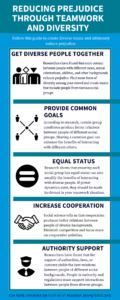Teamwork Guide

Create teamwork conditions that help decrease prejudice
REDUCING PREJUDICE THROUGH TEAMWORK AND DIVERSITY
Follow this guide to create diverse teams and ultimately reduce prejudice
Get Diverse People Together
Researchers have found that mere contact between people with different races, sexual orientations, abilities, and other backgrounds reduces prejudice. Find some form of diversity among your crowd and create teams that include people from various social groups.
Provide Common Goals
 According to research, certain group conditions produce better relations between people of different social groups. Sharing a common goal can enhance the benefits of interacting with different others.
According to research, certain group conditions produce better relations between people of different social groups. Sharing a common goal can enhance the benefits of interacting with different others.
Equal Status
 Research shows that ensuring each social group has equal status can also amplify the benefits of interacting with diverse people. If power dynamics exist, they should be made irrelevant in your teamwork situation.
Research shows that ensuring each social group has equal status can also amplify the benefits of interacting with diverse people. If power dynamics exist, they should be made irrelevant in your teamwork situation.
Increase Cooperation
 Social science tells us that cooperation produces better relations between people of diverse backgrounds. Diminish competition and focus more on cooperative activities.
Social science tells us that cooperation produces better relations between people of diverse backgrounds. Diminish competition and focus more on cooperative activities.
Authority Support
 Researchers have found that the support of authorities, laws, or customs yields the best relations between people of different social backgrounds. People in authority and regulations must support interactions between people from diverse groups.
Researchers have found that the support of authorities, laws, or customs yields the best relations between people of different social backgrounds. People in authority and regulations must support interactions between people from diverse groups.
 Download this teamwork guide to help you create diverse teams and reduce prejudice.
Download this teamwork guide to help you create diverse teams and reduce prejudice.
Optional Activity: Examine Stereotypical Portrayals in the Media
Goal: Identify stereotypes portrayed by the media for different groups (gender, ethnicity, class, religion, etc.), and examine their impact.
Materials:
-
One large sheet of paper and/or a projector with a large screen
-
Markers
-
Different types of media (magazines, newspapers, music videos, TV shows, commercials, social networks etc)
Activity Plan
-
Divide individuals into teams of 4-5 students. All teams should be assigned a group that falls under the category of gender, ethnicity, class, religion, or sexual orientation etc.
-
Have everyone cut and paste (or take a screenshot of) any media portrayals of the group they were assigned. For example, if they were assigned “sexual orientation,” they should gather all images that portray any type of romantic relationship.
-
Hang up a large paper on the wall with all the cut images displayed or project all the online images gathered onto a large screen.
Discuss the following questions as a large group:
-
What activities are people in the media engaged in? How does this influence how others think of them?
-
How are members of a different group (within the same category) portrayed? How does this further affect the stereotypes associated with this group?
-
How might the ads be different if they were created by the group members themselves?
-
Perhaps there is a lack of representation of certain groups. Talk about why this might be and how invisibility might affect what others think of them.
-
Have individuals read a relevant article from MediaSmarts (although the website is Canadian, many of the media they discuss is from the United States).
-
Discuss how the claims in the article are related to the media images everyone found.
-
Have everyone discuss (in small groups) what they can do to challenge stereotypical portrayals
-
Share ideas with the larger group
-
Ask each person to write down one thing they will commit to do to challenge stereotypes portrayed by the media
Continue to Step 3. After using the teamwork guide, complete the Evaluations to compare your before and after prejudice tendencies.
Adapted from http://www.discoverhumanrights.org/uploads/challenge_the_media_toolkit.pdf

